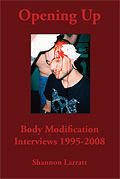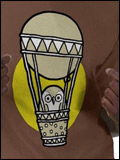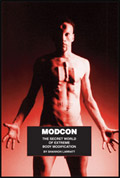These are pictures from the three-hour bus ride ($14 I think) to Cabo San Lucas, where many people are flying into for BMEfest and then taking that same ride. The scenery is fairly nondescript because it's pretty much a desert “dead-zone” where there are no cell phone points or even radio stations. There are power lines though — the power for the region is all generated here in La Paz and then transmitted the rest of the way via high power lines.

Most of the drive looks like this — cacti as far as the eye can see, desert shrubs, and rows of mountains in the background. |

Small farms (I think that's what they are) or ranch homes dot the highway. Some are deserted but most appear to have people living there. |

This photo makes it look a lot more lush than it is. It's mostly dry desert, although there are oasis-like pockets full of green growth and palm trees. |

This is coming into the city of Todos Santos I think. The highway is dotted with small shrines for people killed in accidents. This one isn't, but many of them are constructed with the parts of the car that killed them. |
As I understand it, the highway shrines are not only symbols of the devotion of the family to their lost loved one — they're also a warning to other travelers, saying “be careful; the
peligrosa signs are no joke!” It's a little disconcerting seeing a mangled bumper or the hood of a car with a rumpled, roughly body-shaped indentation wired to a fence pole with a cross sitting in front of it. It's sort of like those mangled MADD-sponsored drunk driving wrecks you see in America and Canada with a little less indignation and a little more Catholicism in the mix.

A small number of the farms are irrigated and stand out from the rest.
|

Cows behind a fence? How strange! You'll see cows, goats, and donkeys wandering around as if they've escaped, but they're not wild. They're all branded and owned, and the fellows you see here may well be on your dinner plate one day.
|

This is part of the main beach in Cabo San Lucas.
|

More of the beach in Cabo. This is one of the rocky parts of course; most of it is sand beach, but this is more fun to explore because it's more alive — fist size crabs are scampering all over these rocks.
|

If you've ever seen a tourist promo-photo of Cabo San Lucas, this arch (in the far background) is the one you'll probably see. At low tide you can walk to it, and at high tide you can sail around it. |

It's cruise ship central. Every day we saw three or four big cruise ships come into the main bay, hang out for a while, and leave. They seem to put off a lot of smoke. |

This satellite base-station was in one of the small towns between Cabo and La Paz. I'm assuming it supplies Internet and/or telephone service to the neighboring community. Or the guy's the biggest geek on the Baja. |

Sunset on the drive home. |
Cabo has a very different crowd of people than La Paz. It's very English-speaking and American tourist-oriented, so you'll see US flags hanging everywhere, and there's much more of an
“ugly American” vibe to the visitors. La Paz tends to draw more of the people who want to experience Mexico (versus just
somewhere warm) and stay a little longer… There's the occasional ass that'll walk into a restaurant and loudly demand,
“doesn't anyone here speak American?“ but it's the exception. Most visitors here enjoy being in Mexico, and do their best to respect local customs and even stumble through a little Spanish when ordering their meals and so on.
You always meet interesting people here. On the bus ride sitting across from us was a guy from Guadalajara who was very excited to meet Canadians, because it's one of his dream destinations. I don't really think about it because these days I'm the ethnic minority, but Mexico is very mono-ethnic (culturally and racially)… At least in this region, other than tourists, it's pretty much an exclusively Hispanic population — no Asian population, no black population, no mix of European cultures (unlike cosmopolitan regions of the Hispanic world such as Buenos Aires). Anyway, of all the things he wanted to experience about Canada it was the embrace of multiculturalism and getting to live in a real world community, and I have to agree with him that's one of its perks.
There was also a narc cop, from Arizona, on the bus. He was complaining about how kids in the small college town he'd been assigned to didn't understand that when he was arresting them for pot, he was just trying to help them. He didn't want them to spend their lives in prison, but as he put it, “people have to be free to make their own decisions; they just have to learn for themselves what happens if you do drugs” — yeah, because throwing people in prison really teaches them about freedom.
He was sitting next to a retired social worker with equally idiotic views who did quite a bit of complaining about her vertigo problems. The narc had just gotten back from Iraq, not as a soldier, but as a missionary — like many other white guys down here, he's a Mormon trying to convince people to dump the Pope in exchange for Joe Smith. At the end of their conversation, her held her hands, looked deep into her eyes, and said very seriously,
“Other than your vertigo, is there anything else I can pray for?”


















